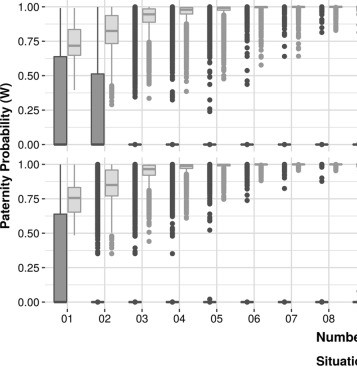Noninvasive prenatal paternity determination using microhaplotypes: a pilot study.
The use of noninvasive techniques to determine paternity prenatally is increasing because it reduces the risks associated with invasive procedures. Current methods, based on SNPs, use the analysis of at least 148 markers, on average. To reduce the number of regions, we used microhaplotypes, which are chromosomal segments smaller than 200 bp containing two or more SNPs. Our method employs massively parallel sequencing and analysis of microhaplotypes as genetic markers. We tested 20 microhaplotypes and ascertained that 19 obey Hardy-Weinberg equilibrium and are independent, and data from the 1000 Genomes Project were used for population frequency and simulations. We performed simulations of true and false paternity, using the 1000 Genomes Project data, to confirm if the microhaplotypes could be used as genetic markers. We observed that at least 13 microhaplotypes should be used to decrease the chances of false positives. Then, we applied the method in 31 trios, and it was able to correctly assign the fatherhood in cases where the alleged father was the real father, excluding the inconclusive results. We also cross evaluated the mother-plasma duos with the alleged fathers for false inclusions within our data, and we observed that the use of at least 15 microhaplotypes in real data also decreases the false inclusions. In this work, we demonstrated that microhaplotypes can be used to determine prenatal paternity by using only 15 regions and with admixtures of DNA.
Authors
Jaqueline Yu Ting Wang; Martin R Whittle; Renato David Puga; Anatoly Yambartsev; André Fujita; Helder I Nakaya
External link
Publication Year
Publication Journal
Associeted Project
User-friendly computational Tools
Lista de serviços
-
StructRNAfinder: an automated pipeline and web server for RNA families prediction.StructRNAfinder: an automated pipeline and web server for RNA families prediction.
-
CEMiTool: a Bioconductor package for performing comprehensive modular co-expression analyses.CEMiTool: a Bioconductor package for performing comprehensive modular co-expression analyses.
-
webCEMiTool: Co-expression Modular Analysis Made Easy.webCEMiTool: Co-expression Modular Analysis Made Easy.
-
Assessing the Impact of Sample Heterogeneity on Transcriptome Analysis of Human Diseases Using MDP Webtool.Assessing the Impact of Sample Heterogeneity on Transcriptome Analysis of Human Diseases Using MDP Webtool.
-
Predicting RNA Families in Nucleotide Sequences Using StructRNAfinder.Predicting RNA Families in Nucleotide Sequences Using StructRNAfinder.
-
OUTBREAK: a user-friendly georeferencing online tool for disease surveillance.OUTBREAK: a user-friendly georeferencing online tool for disease surveillance.
-
Noninvasive prenatal paternity determination using microhaplotypes: a pilot study.Noninvasive prenatal paternity determination using microhaplotypes: a pilot study.
-
Editorial: User-Friendly Tools Applied to Genetics or Systems Biology.Editorial: User-Friendly Tools Applied to Genetics or Systems Biology.
-
Automatic detection of the parasite Trypanosoma cruzi in blood smears using a machine learning approach applied to mobile phone imagesAutomatic detection of the parasite Trypanosoma cruzi in blood smears using a machine learning approach applied to mobile phone images
-
Tucuxi-BLAST: Enabling fast and accurate record linkage of large-scale health-related administrative databases through a DNA-encoded approachTucuxi-BLAST: Enabling fast and accurate record linkage of large-scale health-related administrative databases through a DNA-encoded approach
-
Ten quick tips for harnessing the power of ChatGPT in computational biologyTen quick tips for harnessing the power of ChatGPT in computational biology

